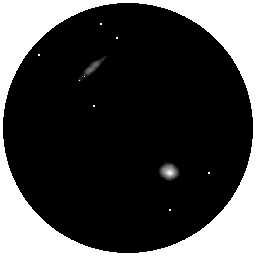 |
| M81 (lower right) and M82 in Ursa Major.
These galaxies appear in the same low power field. Higher powers can be used to zoom in on them separately. |
 |
| M81 (lower right) and M82 in Ursa Major.
These galaxies appear in the same low power field. Higher powers can be used to zoom in on them separately. |
The main classes of galaxies are spiral, elliptical, and irregular. In most cases, the spiral structure of a galaxy will not be apparent, and ellipticals have little structure to delineate anyway. The detail you will be looking for is principally in the galaxy's shape: Is it more or less round or elongated? Is there a bright nucleus? Can you see any extensions which might be spiral arms? Are there faint and bright zones or mottled textures within the visible disk of the galaxy?